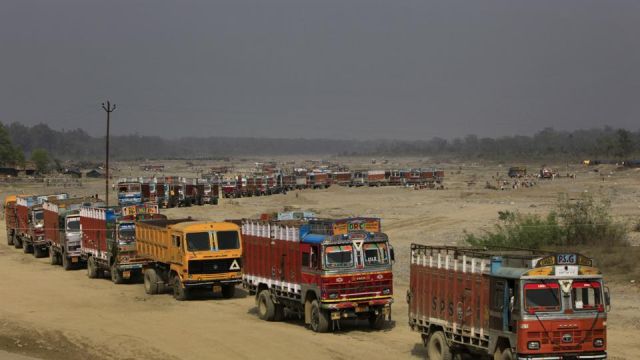
by Editor | May 25, 2021 | News

For representational purpose only (file photo)
Patna : Nearly 1,000 students were expelled for cheating during the Class 12 examinations in Bihar, officials said on Saturday.
Anand Kishore, the Chairman of the Bihar School Examination Board (BSEB), told the media here that more the students were expelled “for adopting unfair means” during the examinations that concluded on Friday.
The examinations had started on February 6.
The chairman said that 25 fake examiners were also caught and FIRs were lodged against guardians for helping their wards to cheat in the examinations.
He claimed the examinations this time were held in a fair manner this time and mass cheating in Bihar was a thing of the past. “It is not possible now.”
Nearly 112,07,986 students appeared for the Class 12 exams at 1,384 centres across the state.
Mass cheating has been reported in Bihar for years.
Last year, the Class 12 Arts topper turned out to be a 42-year-old man, who had faked his age to take the test. He was arrested on charges of fraud.
—IANS

by Editor | May 25, 2021 | News, Politics
 By Imran Khan,
By Imran Khan,
Patna : A man-made sand crisis in Bihar over the past five months has angered all stakeholders: Thousands of labourers, skilled workers, traders dealing in bricks, cement and iron rods — as also contractors in the construction and infrastructure sector and builders.
Even truck and tractor owners, who are mainly engaged in transportation of sand, are unhappy with the crisis badly hitting private and public construction, including major infrastructure projects worth thousands of crores of rupees.
It was evident recently in Bhojpur district, about 60 km from Patna, when thousands of labourers, sand miners, traders and contractors associated with the construction industry staged protests that disrupted trains to enforce a shutdown called against the state government’s sand mining policy.
Similar small protests were also reported from Vaishali and Saran districts in the past week.
It is a hard fact that thousands of daily wagers and semi-skilled workers have been rendered jobless and are fighting for survival, after the Janata Dal (United)-Bharatiya Janata Party (JD-U-BJP) government led by Nitish Kumar initiated large-scale action in July against rampant illegal sand mining and control by “balu-mafia” (sand mafia) and put restrictions on sand mining.
While the government had good intentions, the steps resulted in scarcity of sand.
“One cannot move a step ahead without sand; it is the most important construction material. We have money, cement, bricks, iron rods, labourers and masons, but without sand, construction activities have come to standstill for months,” said N.K. Thakur of the Builders Association of India, Bihar chapter.
Private construction and public infrastructure projects in the state have been badly hit by sand shortage after the state banned sand mining along the riverbeds. It also affected the construction of houses for the poor under the Pradhan Mantri Awas Yojna Gramin (PMAY-G).
“Sand scarcity has hit the construction work of the PMAY-G. It is a difficult challenge to complete 400,000 houses for the rural poor by the end of March,” said Arvind Choudhary, Principal Secretary, Rural Development Department.
Work under the Mahatma Gandhi National Rural Employment Guarantee Act (MGNREGA) has also suffered and this has a direct bearing on the employment of the rural poor.
Sand is now a costly item in Bihar. It is selling at a premium — from Rs 6,000 to Rs 8,000 for 100 cubic feet. Ahead of the crisis, sand was available in the market at Rs 2,500 to Rs 3,000 for 100 cft.
“Costly sand has raised the cost of construction and most private and public construction has slowed down like never before,” said Sahid Malik, a contractor.
A builder said the per tractor cost of sand has touched an all-time high.
“The sand crisis has affected over 1,000 under-construction apartments in and around Patna, not to talk about thousands of houses. Construction activities are badly hit as big building construction and infrastructure projects have been stalled for the last four months,” said the builder, on condition of anonymity.
According to officials, the sand crisis began after the government put restrictions on sand mining through the Bihar Minor Mineral Rules, 2017.
“Soon after, the government launched a statewide crackdown on illegal sand mining that created havoc among the sand mafia. It was a right step to check illegal sand mining to increase revenue of the government and to provide cheap sand to people. But nothing has happened and it has only created a sand scarcity that has angered the people,” an official said.
Taking advantage of the people’s anger over the crisis, the opposition Rashtriya Janata Dal (RJD) had called for a shutdown in Bihar on the issue on December 21.
“The new sand mining policy has not only rendered hundreds of thousands of construction workers and others jobless but has also created an acute shortage of sand, resulting in a price escalation that has badly hit construction activities,” Leader of Opposition Tejashwi Yadav said.
In a major setback to the state government, the Patna High Court has ordered that sand mining activities would continue as per older, un-amended rules. The court has also put a stop on all orders and directives issued by the department after the November 27 stay on the implementation of new Bihar Minor Mineral Rules.
After the National Green Tribunal’s order suspending sand mining activities during the monsoon season ended on September 30, the state government has given clearance to sand mining in 10 districts; but that did not include Patna, Bhojpur, Vaishali and Saran that account for over 50 percent sand mining in Bihar.
(Imran Khan can be contacted at imran.k@ians.in)
—IANS

by Editor | May 25, 2021 | News, Politics
 By Anand Singh,
By Anand Singh,
New Delhi/Patna : The NIA, which arrested suspected LeT operative Abdul Naeem Sheikh from Uttar Pradesh last month, has summoned a District Transport Officer (DTO) of Bihar for his alleged links with the terrorist, an official said.
The National Investigation Agency (NIA) arrested Sheikh alias Nomi, 37, on November 28 from Charbagh bus stand in Lucknow in a joint operation with the Uttar Pradesh Police’s Anti-Terrorist Squad (ATS).
The NIA official, on condition of anonymity, told IANS they have summoned a DTO officer, identified as Diwakar Jha, posted in Bihar’s Buxar district, for questioning over his alleged links with Sheikh.
According to the NIA official, Jha had inaugurated Sheikh’s coaching centre in Bihar’s Gopalganj district in 2015, when he was posted there.
The official said the anti-terror probe agency has recovered some pictures of Jha with Sheikh.
Sheikh, who is said to have done a recce of army and power installations in Jammu and Kashmir, was caught after he applied for a passport under a fictitious name.
The NIA official said that security agencies stumbled upon a lead to Sheikh after a man complained that his address was being used by the LeT operative for his passport.
“He had applied for a passport on the address of Sarraj Ahmed, a resident of Gopalganj’s Jungalia area in Ward No 19.”
“But before he could get his passport in hand, Ahmed approached police and complained about it,” the official said.
“He got his Pan card and Aadhaar card, which were also made on the same address under the name of Sheikh Sohail Khan,” the official said.
“Sheikh resided in Gopalganj till March 2017,” he added.
Sheikh was hiding in Bihar’s Gopalganj district by changing his name after escaping from the custody of central agencies in August 2014.
The suspected LeT operative was wanted by security agencies in various cases, including the Mumbai train attacks of 2006-2007.
He was earlier nabbed by security agencies at that time and was under trial. In August 2014, he managed to give the slip to security agencies and escaped when he was being taken from Dum Dum Central jail (Kolkata) to Mumbai to appear in court. He fled while the train was passing through the thick forests of Chhattisgarh.
After fleeing from custody, Sheikh established a new sleeper cell under instruction from his LeT handler Amjad, the official said.
The case has been handed over to the NIA for further probe.
On December 2, the NIA has arrested a youth leader Dhannu Raja from Gopalganj for his alleged links with Sheikh.
Sheikh is also an accused in the Aurangabad arms haul case and was arrested by the West Bengal police in 2007 while entering India from Bangladesh along with two Pakistanis and one Kashmiri.
Security agencies have dubbed Sheikh as “David Coleman Headley” as he had been following in his footprints and did reconnaissance of similar areas.
Pakistani-American Headley is serving a 35-year prison sentence in the US for his involvement in terror activities and the 26/11 Mumbai terror attacks of 2008.
(Anand Singh can be contacted at anand.s@ians.in )
—IANS

by Editor | May 25, 2021 | Books
 By Saket Suman,
By Saket Suman,
Book: The Bhojpuri Kitchen; Author: Pallavi Nigam Sahay; Publisher: Westland; Price: Rs 499; Pages: 166
Biharis love their food, don’t they? Why else would they carry their “achaar” to far off cities where many of them migrate for work, or queue up in front of the “litti-chokha” stalls outside Metro stations? Now, a trained chef explores the varied cuisine of the state and describes her discovery of the “bhansa ghar” in a new book.
“The Bhojpuri Kitchen”, authored by Pallavi Nigam Sahay, also carries wonderful pictures of the cuisine by photographer Shabin E. Chef Nigam, who trained at the Grand Hyaat, Mumbai, received her culinary diploma from the International School of Italian Cuisine (ICIF).
Strangely, the author did not grow up around the “Bhojpuri Kitchen” and it was only after her marriage that she came to develop an interest in the state’s cuisine. Her curiosity about Bihari cuisine began on her “kacchi” (a ceremony performed a day after the wedding, where traditional dishes are prepared and served to the bridegroom’s party).
“I was absolutely fascinated that day by the delicious baingan badi ki sabji (aubergine curry with black gram cakes), pachphoran kohra (pumpkin cooked with five whole spices), machli ka sarsowala jhol (mustard fish curry), mutton curry, arwa chawal (parboiled rice), spicy chicken kababs and kaala jamun (Cotton cheeses dumplings in sugar syrup). Since then I have been on an unending saga of loving and learning Bihari food. This book is about my beautiful journey across various Bhojpuri bhansa ghars (kitchens),” Sahay writes in the introduction.
She also reminds her readers that almost every festival in Bihar — Holi, Diwali, Dussehra or Chhath — is more about celebrating food and serving different dishes than anything else.
“In fact, Biharis even change their wedding dates to complement their appetites. I have never been to a family wedding on a Tuesday or a Thursday, the two days when the majority abstain from eating non-vegetarian food. No wonder then that one of their ex-CMs was called Rabri, and many kids in the state still respond to a sweet name — Laddoo,” she notes.
So what does a usual day in the Bhojpuri kitchen look like?
Sahay paints a complete picture at the onset of the book. It starts with the aroma of fresh tea simmering on fire. During summer, a refreshing elaichi (cardamom-flavoured tea) is preferred, while on colder mornings a hot, adrak masala chai (spiced ginger tea) is welcome. And this is a very special time as all family members sit together before getting busy with their daily chores.
A traditional lunch comprises steamed rice, daal, bhujia, curd and salad. It used to be the main meal of the day, eaten together by all family members at home. But obviously, owing to altered lifestyles, eating patterns have changed. For evening snacks, there are bachka, bhabhra (Bengal gram pancakes) and choore ka pulao (flaky rice with green peas). They go perfectly with a cup of tea.
Dinner, Sahay mentions, is usually a combination of roti and two types of vegetables. Most families in Bihar, the author maintains, do not opt have rice for dinner, although they may add a non-vegetarian dish such as chicken or mutton to the meal. The menu is a little more elaborate on the weekends.
Sahay also provides elaborate recipes for a wide variety of Bihari dishes — the legendary litti chokha; choora mattar; Bihari halwai-style mutton; machli ka sarsonwala jhor; the delectable bhujias; the unique parwal ki mithai, thekua and other fantastic sweets.
“The Bhojpuri Kitchen” is not only a celebration of several recipes, lest they be forgotten in the future, but also of the region’s festivals like Chhath, which is yet another reason for the kitchens to come alive with food befitting the Gods.
(Saket Suman can be contacted at saket.s@ians.in)
—IANS

by Editor | May 25, 2021 | Business, Large Enterprise, Markets, News
 Patna : The Bihar State Co-operative Milk Producers’ Federation (COMPFED), which sells milk and milk products in the state and outside it under the brand name of “Sudha”, on Thursday increased prices of the two available varieties of milk by Rs 2 and Rs 3 per litre.
Patna : The Bihar State Co-operative Milk Producers’ Federation (COMPFED), which sells milk and milk products in the state and outside it under the brand name of “Sudha”, on Thursday increased prices of the two available varieties of milk by Rs 2 and Rs 3 per litre.
This decision of COMPFED surprised millions of people, who are busy preparing for Durga Puja that began on Thursday, as use of milk doubles during this festive season in every family.
Consumers in Bihar would have to pay Rs 2 and Rs 3 more for a litre of milk from Friday, officials said.
A COMPFED official told IANS that the new prices would be effective from Friday.
“The milk prices of Sudha brand will be Rs 2 and Rs 3 costlier now,” the official said, elaborating that Sudha Shakti would now be available at Rs 41 a kg from Rs 39 and Sudha Gold at Rs 48 per litre from Rs 45.
COMPFED’s officials justified the increase in milk prices, saying that farmers would benefit from it. “Now farmers will get Rs 1.5 to Rs 2 more per litre.”
However, common consumers have expressed their anger over it. “At a time when common people are struggling, increase of milk price by Rs 3 is bad news for us,” said Saket Kumar, a businessman.
Opposition Rashtriya Janata Dal has also criticised the state government’s decision to increase milk prices on the eve of Durga Puja.
—IANS





